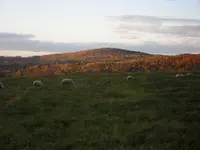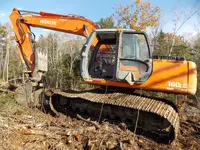Your sample are very similar to the ones i crush. They don"t have as much Pyrite. But a lot of quartz. The top two of your samples if were left in water I think they would become very crumbly.Usually my understand is most of the gold. Comes from the rock that runs along side . The Quartz veins. If I had more rocks to crush. I thought about doing some thing to a wood splitter. Most of the lode gold around here. Was caused by faults. And this type of heating of the rock and water. When it was pushed to the surface.So most of this action was small in scale. Making only small veins of gold. Most of the bigger gold comes from areas of bigger volcanic activy. My take. Anyway your on the right trail.
Once the frost gets out of the ground, I can check my gravel pit. My Father-in-law is convinced gold is there, but I am not sure. It will be a few months before I can check, so I have been concentrating on lode gold.
I do have a few areas where there is bedrock, so I thought I would look for gold along that first.
I work with a lot of soil scientist here because I am a farmer, and because I get government grants, I have to have my gravel pass federal inspection. I asked her about gravel being in that pit, and she scoffed, so I am not so hopeful. She was a soil engineer in Alaska before coming here, so I would think she would know more about gravel and gold than anyone. (Of course I would still like to prove her wrong!)
It is good gravel, just too good. It is more for surface then base material for roads because it is very fine gravel, 2 inch minus, with very little dirt. It sounds like washed rock when you dump a bucketful into a truck, so she makes me mix overburden with it in order to get it to pack for the roadways. As for layers, there is the overburden of course, then several feet of gravel, then a layer of clay that is about a foot thick. Then under that is the best gravel you have ever seen. Nice sharp rock, no dirt, and rocks no bigger than two inches. That goes down to bedrock which can be a foot down, or all the way to 32 feet down (according to test bores). Unfortunately the water table is not very deep though, maybe 10 feet down in most places. Total acreage is around 8 acres, but fortunately is grandfathered on environmental laws because we have been digging out of this pit before 1970.
I had nothing to do yesterday as it was just too cold, so I was looking up a way to process gravel if it does hold some promise of gold. Again I am doubtful, but a Keene 151s Drywash system looked to be about what I need. I would probably add a trommel to prescreen out the rock and make the system all hydraulic so I can mount it on my Wallenstein and direct load it with the backhoe. Keene claims production of up to two tons per hour which is about what my little backhoe could do. That would be fine for what I would want to do, I am just not sure how often the cleanout has to take place on that Keene 151S. If it was every few yards, that would kind of be a pain to do as I would have to stop digging every hour. Maybe that is just what is required in digging for gold? (I have no idea)
The Wallenstein would work well, except that it does not dig very deep. It is perfect size for the Keene Drywasher, but the Hitachi would be too big. It also does not go deep enough. I need 32 foot digging depth, and all it can dig is 18 feet below the tracks. There is a Hitachi 1100 down in MA that has a 34 foot digging depth, and the guy only wants $61,000 for it, but it would take another $61,000 to truck it up here and put it back together! I got two houses up for sale now, and if they sold I might consider it, but I am sure my wife has plans for the money, and it is not in buying a Hitachi 1100 excavator! (LOL)





